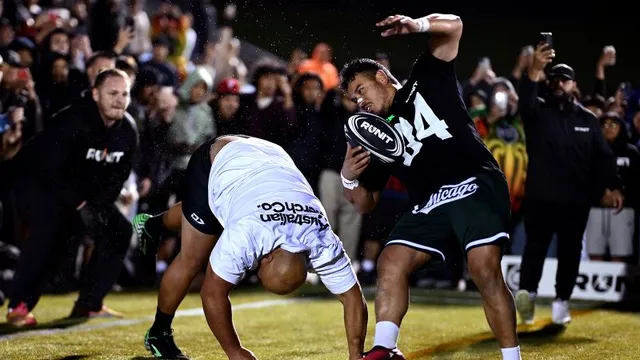
Young man dies after fatal collision in social media-driven tackle game
2025-05-30 00:00- A 19-year-old man suffered a serious head injury while playing a social media-inspired tackle game called 'run it straight'.
- Despite the popularity of the game among youth, it carries significant safety and injury risks.
- This tragic incident emphasizes the need for better safety measures in informal sports to protect participants.
Express your sentiment!
Insights
In New Zealand, a tragic incident occurred when a 19-year-old man named Ryan Satterthwaite suffered a serious head injury while playing a tackling game known as 'run it straight' with friends in Palmerston North. This game, which has gained popularity on social media, involves two participants running at each other and colliding without any protective gear. The social media trend has raised concerns about safety, especially after numerous incidents of injuries have been reported in similar games. After sustaining his injury during the game on Sunday, Satterthwaite was hospitalized but ultimately succumbed to his injuries on Monday. Police have described the event as a tragedy, underscoring the significant risks associated with this type of social media-inspired activity. Inspector Ross Grantham pointed out that while this game was an impromptu match among friends and not a formal event, it highlights the inherent dangers involved. There has been a growing trend in New Zealand and Australia where 'run it straight' has evolved into an informal sport, even leading to the organization of tournaments, despite warnings from experts about the potential for long-term head injuries and trauma. The game, informally played for years, has faced criticism and concern, especially as it attracts players of all ages from young children to adults. Organizers of various events have even begun promoting it as the 'world’s fiercest new collision sport', aiming to create an organized competitive environment. However, the popularity has led to incidents where participants suffer severe injuries. Furthermore, this incident has sparked a call for better safety measures such as wearing protective headgear and implementing spotters during games, to help prevent serious injuries in the future. In light of this tragedy, community leaders and event organizers have expressed the need for increased awareness and guidance regarding safe play practices. This includes informing players about the risks of such casual contact sports and the importance of medical oversight during play. Advocates are emphasizing a need for critical safety standards to protect players engaging in this rapidly growing, yet dangerous, social media trend, ensuring that the fun of informal sports does not come at the cost of health and safety.
Contexts
The impact of social media on youth activities is significant and multifaceted, reflecting both positive and negative dimensions. Social media platforms, such as Facebook, Instagram, TikTok, and Snapchat, have transformed how young people interact, communicate, and engage with their peers. These platforms facilitate connectivity, allowing youth to express themselves, share experiences, and forge relationships regardless of geographic barriers. For instance, social media enables young individuals to join communities centered around personal interests and hobbies, which promotes social engagement and collaboration among peers. Furthermore, social media can serve as a powerful tool for activism, with youth mobilizing around social issues, sharing information, and influencing public opinion on matters ranging from climate change to human rights. It amplifies their voices and ideas, fostering a sense of agency and participation in societal discourses. However, the pervasive presence of social media also raises concerns regarding its influence on youth well-being. Research has shown correlations between excessive social media use and a range of mental health issues, including anxiety, depression, and low self-esteem. The pressure to curate an idealized online persona can lead to feelings of inadequacy and loneliness, especially when young people compare themselves unfavorably to others' posts. Additionally, the addictive nature of social media can interfere with academic performance and reduce participation in physical activities, as youth may prioritize screen time over face-to-face interactions or outdoor play. Cyberbullying also emerges as a significant concern, with young individuals facing harassment and negative interactions that can have long-lasting psychological effects. The impact of social media on youth activities also highlights the changing landscape of education and informal learning. Online platforms have become vital resources for information, offering access to educational content, tutorials, and collaborative learning opportunities. Social media can enhance creativity by providing spaces for youth to showcase their talents, such as art, music, and writing. Educational institutions are increasingly acknowledging the relevance of social media in learning environments, integrating it into curricula to enhance student engagement and digital literacy. Furthermore, the rise of online communities has fostered collaborative projects and peer-led initiatives, emphasizing the importance of teamwork and communication skills in a digital age. In conclusion, the influence of social media on youth activities is a double-edged sword that requires careful navigation. While it provides unprecedented opportunities for connection, creativity, and activism, it also poses challenges related to mental health and social development. Understanding this complex relationship is crucial for parents, educators, and policymakers as they seek to harness the benefits of social media while mitigating its adverse effects. Continuous research is essential to explore effective strategies for supporting youth in developing healthy social media habits and promoting a balanced engagement with digital environments.